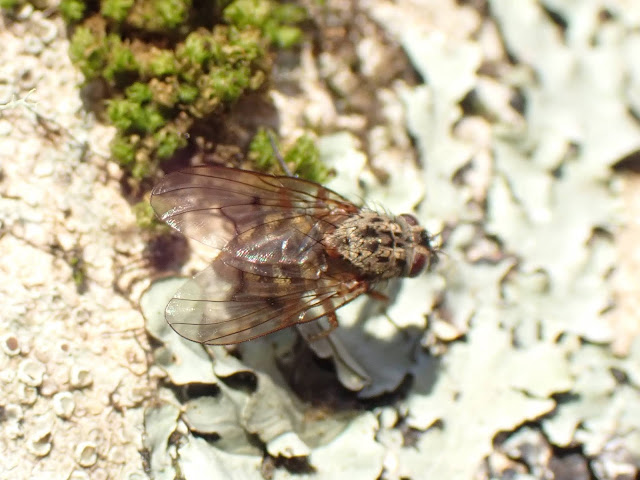Today was stunningly bright and sunny, the wind had dropped to a breeze and, depending on where I stood, it even felt warm from time to time! I hurried through my jobs for the morning and managed to hit Uig Wood in glorious sunshine. I was so confident of finding flies that I decided not to haul my sieve and tray up the hill. Today was about the flies, spiders could wait for once.
 |
| Lowest tide of the year so far and what did I do? I went up to the woods instead! |
Tomorrow I'm kayaking out to an island in search of corals and anemones, taking advantage of the huge lows. Today I stuck to solid earth, armed with my net and a shedload of pots and tubes. Would I skore?
 |
| My target - broad tree trunks bathed in warm sunlight |
I was quietly expecting to find a good few dozen flies sunning on tree trunks, the stark reality was that I found ten or so of one species and two of another. And no calliphorids at all, which surprised me. This was the first 'proper' fly, as Skev would call it, that I've found in the woods this year. Potted for pics but released afterwards, this is one of the few muscids I can ID in the field.
 |
| Phaonia tuguriorum - a very common fly at this time of year |
This is a distinctive looking fly, the clear wings have clouded cross-veins which are very noticeable in life. Unfortunately, despite taking lots of shots of these flies, none of my images show these wing clouds very well. Here's a crop of the image above, hopefully you can see the short basal cloud (looks like a darkened dot) and the longer cloud closer towards the wingtip.
There are other features to aid identification, though any brownish muscid with clouded cross-veins at this time of year is quite likely to be Phaonia tuguriorum. Confirmatory features include the largely orange legs with just the fore femora darkened, the antennal bases are orange and the only acrostichals are the pair near the scutellum. All of the ones I saw today were female, their broad brownish frons being another noticeable character to aid ID. Set of images below, hopefully you can discern at least some of those features. The bright sun on pale bark didn't make for easy shots.
 |
| You can see the clouded cross-veins quite well in this image |
 |
| Note the bulge in the wing outline about a third of the way from the shoulder to the wingtip |
 |
| The widely separated eyes with brown frons indicate that all of these flies are female |
The other two flies I saw, also sunning on tree trunks with the Phaonia, eluded my attempts with the net. They were much smaller, I feel they may have been a Fannia species maybe. Hopefully I'll get another chance with them sometime soon.
There were plenty of leggy flies dancing up and down in the deeper shadows, Trichocera in the main though I netted three small individuals from a modest swarm and I don't recognise the family. I'll pin them and run them through the keys. Just because the 'proper' flies have finally woken up doesn't mean I intend to ignore the leggy ones! (Edit - they are Dixidae).
Despite not bringing a sieve with me, I did still notice and subsequently pot a very small spider. Probably the smallest spider I've ever collected with a mind to identifying, but through my handlens I could see that it had enlarged and fully-formed pedipalps, hence an identifiable male. Plus it had a great big bulge on top of its head, I'm wondering if it is an Erigone. Hopefully my microscope will have enough magnification to allow me to ID it. I have a backlog of a maybe twenty to thirty specimens sitting in alcohol, I need to get that under control sooner rather than later. It's only going to become busier as the seasons progress.
 |
| This spider is about 2mm body length!!! |
















Refreshing to see a proper fat bodied fly rather than those pathetic small leggy pretenders 🤣
ReplyDeleteHaha yeah, tell me about it!
Delete